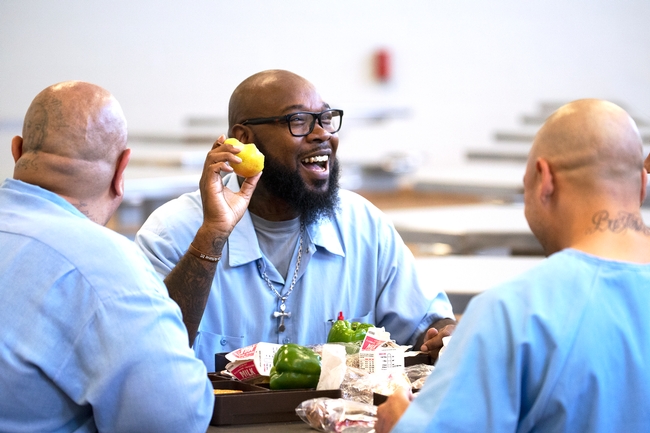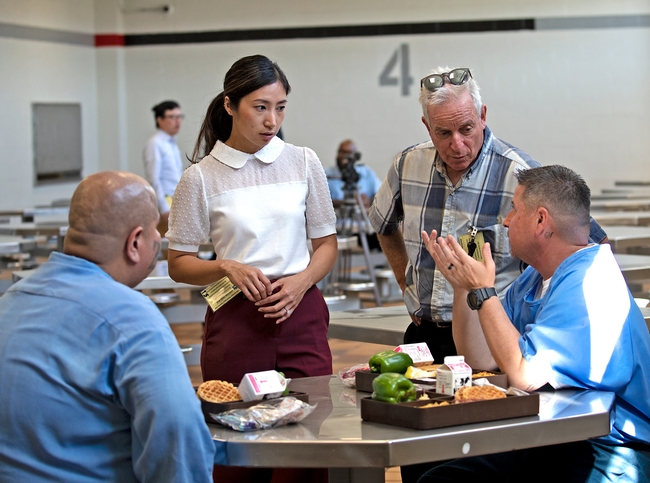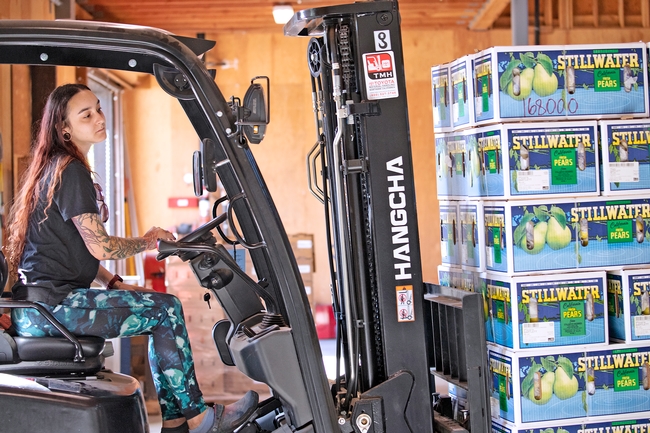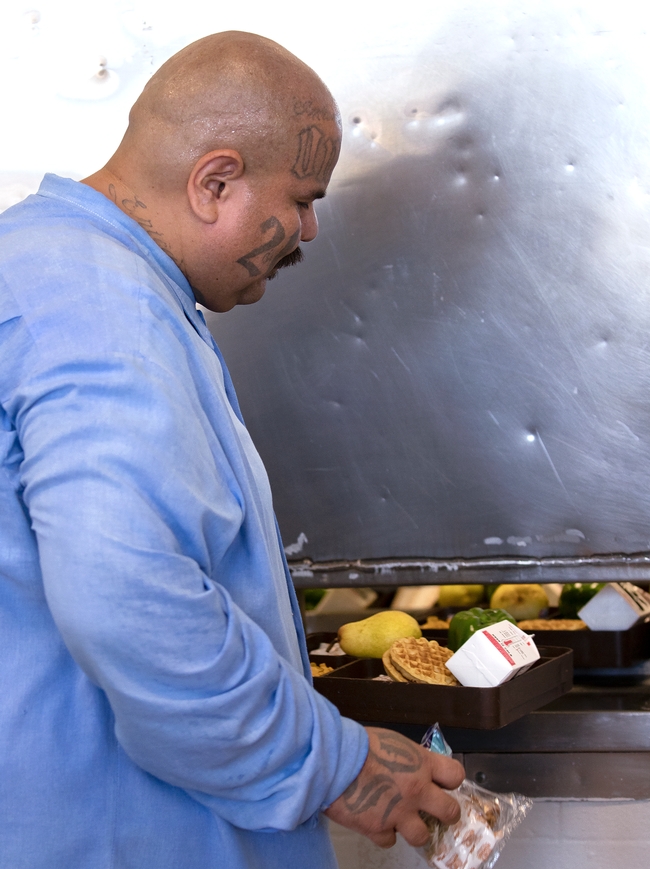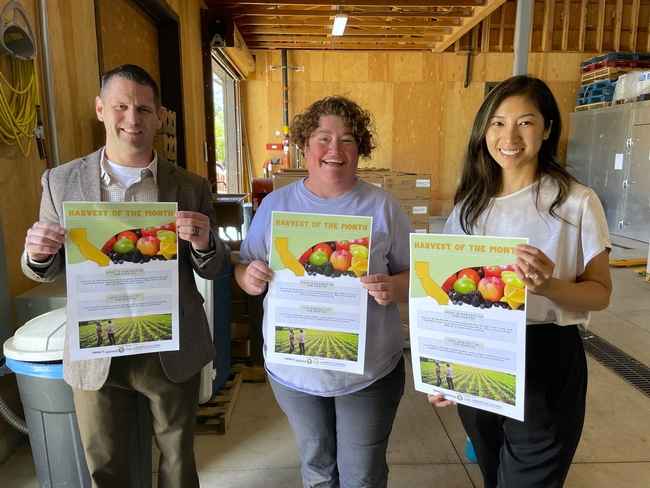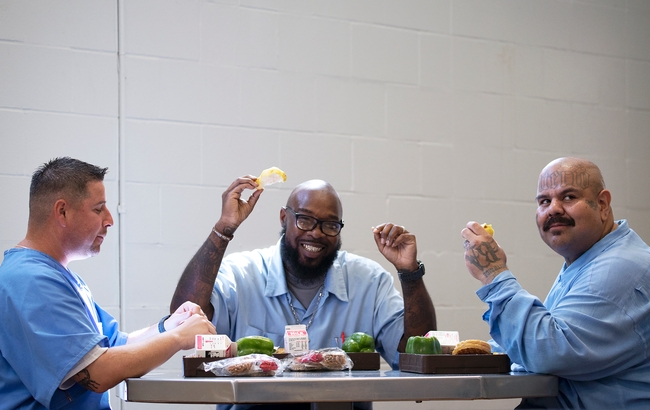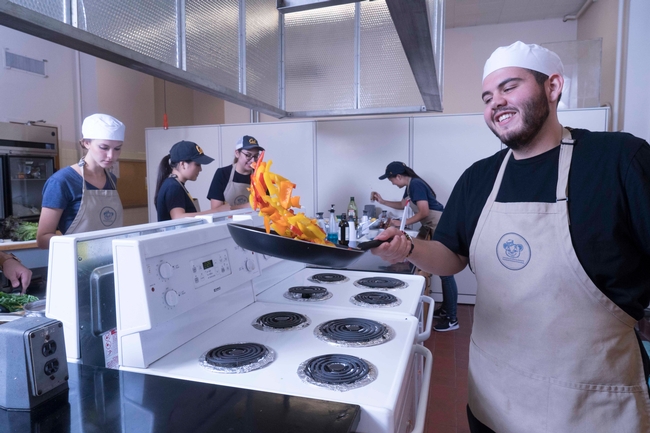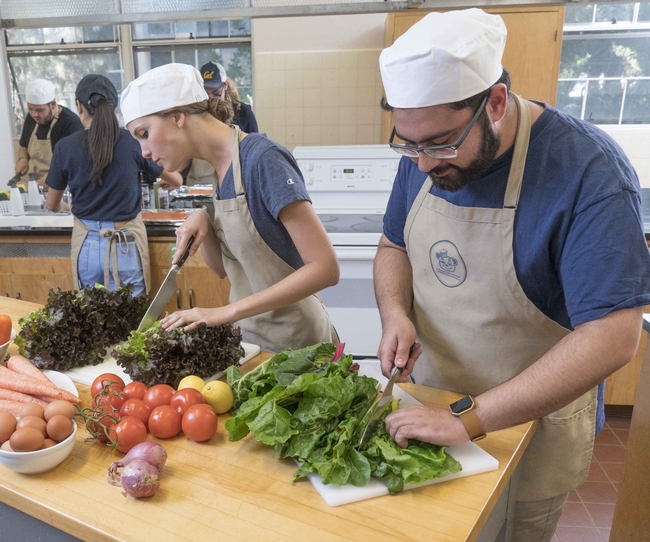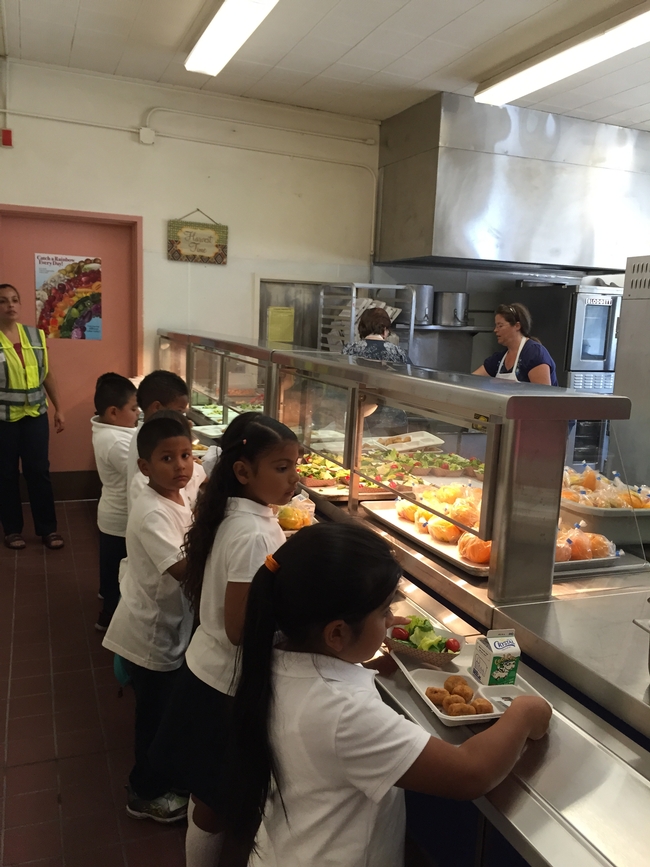Posts Tagged: NPI
‘Farm to corrections’ project provides fresh produce to people in prison, boosts California growers
Nutrition Policy Institute, Impact Justice, ChangeLab Solutions partner with California Department of Corrections and Rehabilitation
Serving slices of watermelon on the Fourth of July is a long-standing tradition at some facilities within the California Department of Corrections and Rehabilitation. But this July, there was something different about the watermelon offered to the approximately 8,000 residents at California State Prison Solano, California Medical Facility and Folsom State Prison.
It was juicy. It was sweet. It was “scrumdiddlyumptious,” according to one resident. And it was grown on a California family farm.
The three institutions are part of a “farm to corrections” project, Harvest of the Month, which aims to serve seasonal, locally grown produce to people who are incarcerated in California, while opening new opportunities for California farmers.
“We appreciate that someone cares enough to introduce this program that gives us something new,” said Jason Romero, a California State Prison Solano resident. “We look forward to what's coming in the future – California has the best stuff, right? – and hopefully we get other varieties of stuff.”
The program – bringing together the Nutrition Policy Institute, the nonprofit Impact Justice, and ChangeLab Solutions in collaboration with CDCR – was officially launched with the watermelon delivery in July. Pluots followed in August, and Bartlett pears were delivered in September.
“It's a ‘multiple wins' kind of an effort,” said Wendi Gosliner, the NPI principal investigator on the California Department of Food and Agriculture specialty crop block grant supporting the project. “The funding is available because the state is looking for state partners to purchase and expand the markets for California-grown fruits and vegetables. And we know that getting more of those fruits and vegetables on the plates of people who are incarcerated would be a huge bonus for them.”
California State Prison Solano resident Patrick Range said that, after tasting pluots for the first time through the program, the plum-apricot hybrid is now one of his favorites.
“I think I had five of them that day – and I'm waiting for them to have them again so I can get more; they were so good,” Range said. “It's something I'd never experienced, in the outside world or in prison.”
With rave reviews from residents and staff alike, CDCR – the State of California's biggest purchaser of food – is planning to roll out Harvest of the Month to all 33 of its adult facilities within the next two years.
“Food brings individuals together and introducing new products can give those in the care of CDCR something to talk about, as well as look forward to,” said Lance Eshelman, CDCR's departmental food administrator.
Improving conditions for people within correctional institutions is core to the mission of Impact Justice, which is working with partner organizations across the U.S. to bring fresher, more nutritious food to facilities, in support of residents' physical, mental and emotional health.
“We really want to prioritize the holistic well-being of an individual to help ensure that once they come home from incarceration, they are in a place where they are ready to actually contribute back to society,” said Heile Gantan, program associate with the Food in Prison project at Impact Justice.
Range said that enjoying the fresh produce – and learning more about its nutritional value – is helping him live a healthier, more energized, and hopefully longer life.
“I was a kid that didn't like vegetables; I didn't want nothing to do with vegetables…[but] as an adult, being 46 years of age, I want this for myself – I want to be able to tell someone else, to teach someone else about what I experienced when getting these fruits and vegetables that helped that nutritional factor,” he said.
In addition, Gosliner noted that early research suggests better food can benefit not only the well-being of residents but also of staff, with a calmer and safer work environment.
Partnership built on shared values, priorities
Gosliner and Ron Strochlic, academic coordinator at NPI, saw an opportunity to support “farm to corrections” work through a CDFA block grant, which aims to boost the purchase of California-grown specialty crops.
“CDCR is the state's largest single purchaser of food, so they're a natural place to consider ways to improve food systems,” said Gosliner, who was awarded the grant in 2020 to work with partners to research and develop pathways that encourage CDCR procurement of California produce, as well as nutrition programs for formerly incarcerated individuals. The project produced a report summarizing the opportunities and challenges in bringing more California-grown produce to the state's prison system.
The staff at Impact Justice appreciated that the NPI team brought not only research and evaluation acumen to the partnership but also an abiding concern for the people inside correctional facilities.
“Our grant funding was focused on simply increasing access to and consumption of California-grown specialty crops in CDCR prisons, but our team was very much in alignment around values and really focusing on the health and well-being of residents – highlighting and amplifying residents' experiences and voices,” said Leslie Soble, senior program manager of the Food in Prison Project.
Gantan echoed that sentiment, adding that NPI – which is under the University of California Agriculture and Natural Resources umbrella – also contributed its familiarity with regional food systems, particularly food hubs across the state.
According to the NPI team, engaging food hubs – organizations that aggregate, distribute and market food products from local producers – was a logical way to make a “farm to corrections” match.
“The majority of CDCR facilities are located in rural, agricultural regions, so to us, it was kind of a no-brainer to connect those facilities with the local communities and local farmers in the area,” Strochlic explained.
For the Harvest of the Month project, the partners teamed up with Spork, a Davis-based, mission-driven food hub that sources from growers across Northern California. Spork also aggregates the fresh produce from local farmers and delivers it to participating CDCR facilities each month.
“The farmers are very excited to see the change in the systems at CDCR in food and nutrition and what they're offering to the residents – and they're excited for the potential that this has for a larger, more consistent market,” said Hope Sippola, co-owner of Spork, which emphasizes working with underserved farmers as part of its mission. “We really needed to dig deep to figure out how to successfully implement this change of CDCR purchasing from large distributors to a food hub who sources from local family farms.”
Carolyn Chelius, an NPI project policy analyst and project manager of NPI's Farm-to-Corrections work, said the team hopes, as Harvest of the Month scales up, that they will be able to make Spork's generous investment of time and resources pay off.
“Our ultimate goal is to be able to benefit Spork and help them with their business, but it's been really helpful to have them as champions – people who are really interested in the mission,” Chelius said. “I don't know if this project would have been possible otherwise.”
California produce purchasing requirement helped spur project
Of course, cultivating a strong working relationship with CDCR also was essential. On the heels of AB 822 (a policy requiring state agencies to buy California-produced food over other options if the price differential is 5% or less), another powerful impetus for CDCR was the passage of AB 778 in 2022. It requires that, by the end of 2025, at least 60% of food purchased by state-run institutions must be grown or produced in California.
Eshelman, the departmental food administrator, said the law has challenged CDCR to look closely at its statewide menus and identify items that could be sourced from California growers and producers. He said that, through this project, food service team members have gained new knowledge about food production in the state, such as variability due to regional differences and weather trends.
“The Harvest of the Month program provides an additional resource, and places CDCR in contact with subject matter experts such as food hubs and local growers who can provide valuable insight into what to expect in terms of California-grown or produced food items and their accessibility,” Eshelman explained, adding that NPI and Impact Justice also have been vital resources for CDCR.
Gosliner acknowledges the challenges in retooling processes and procedures across CDCR, the second-largest correctional system in the U.S. With nearly 100,000 incarcerated individuals in its care, CDCR purchases more than $163 million in food each year.
“It's a big ask of a major state institution to reconsider some of their systems for doing something that they do every day: providing food to the people who are incarcerated,” Gosliner said. “It's revolutionary for them to rethink who they're sourcing from, to rethink how much fresh produce they're serving, to rethink the variety of that produce – it's a big lift for CDCR.”
‘This is really the beginning'
As CDCR brings Harvest of the Month to more institutions across the state, the collaborators anticipate that the logistics will smooth out – and that more farmers will be willing to participate.
“If we can add some more facilities and increase the volume, we have a better chance of making it work for growers, so we're really hoping that we can continue with this food hub model,” Strochlic said. “For us it's really important to be able to source from small and medium growers as well.”
And while flyers describing the health benefits of each month's “Harvest” item are currently distributed at the participating facilities, the partners hope they can provide additional nutrition education opportunities for the residents – during their time inside and after incarceration (like in the workshops held across the state).
Soble and Gantan of Impact Justice also noted that all members of the project team have been learning together, exploring “new territory” in growing this innovative partnership.
“I know personally I've learned so much from the NPI folks just about policy related to food and nutrition in California and about different nutrition interventions,” Soble said. “To me, it's been a very valuable and positive partnership.”
Gosliner said that building on those relationships will be crucial, as the movement to improve the services provided to incarcerated individuals continues to gain momentum in the state.
“This is really the beginning of California's work,” she said. “Even though we grow so much of the food here, there are other states in the country that are further along than we are in California. This is really the launch.”
Funding for this project was made possible by the U.S. Department of Agriculture's (USDA) Agricultural Marketing Service through grant AM200100XXXXG032. Its contents are solely the responsibility of the authors and do not necessarily represent the official views of the USDA.
Funds from UC Sustainable Agriculture Research and Education Program's Small Grants Program also helped support this project.
Teaching Kitchen course helps improve college students’ food security
Cooperative Extension researcher: Nutrition course a boon for UC Berkeley students
College students across the nation are struggling to meet their basic food needs. Within the University of California system of 280,000 students, 38% of undergraduate students and 20% of graduate students report food insecurity.
As part of the UC Global Food Initiative, in 2015 the Nutrition Policy Institute (a UC Agriculture and Natural Resources statewide research center) identified student food insecurity as a UC systemwide problem, prompting the UC Regents and campuses to collectively address the issue.
All 10 UC campuses now have on-site basic needs centers, providing food, emergency housing and support services. The UC system and campus working groups recognize that meeting basic needs, such as food, is a multidimensional challenge.
In response to the 2022 White House Conference on Hunger, Nutrition, and Health, which called for national efforts to reduce diet-related disease and food insecurity, UC renewed their commitment to cut the proportion of students facing food insecurity in half by 2030. Campuses will partner with local counties to maximize enrollment in the Supplemental Nutrition Assistance Program (also known as CalFresh in California), provide food for students who do not qualify for CalFresh, and allocate campus food resources to historically underserved student populations.
NPI's collaborative researchers continue to monitor the impact of these efforts, in addition to other interventions, such as supporting students in building basic culinary skills, to improve food security. One multipronged approach to address food insecurity at UC Berkeley is a 14-week course on Personal Food Security and Wellness with a Teaching Kitchen laboratory component.
Sarah Minkow, who teaches the Personal Food Security and Wellness course at UC Berkeley, shared that students learn about nutrition and gain culinary skills through the Cal Teaching Kitchen.
The curriculum is designed with consideration for the time, cost and convenience of healthy eating. Discussions include food safety, calculating nutrient needs, mindful eating and reading nutrition labels. The Teaching Kitchen laboratory brings the lessons to life through knife skills, “no-cook” cooking, microwave cooking and sheet pan meals.
Minkow enthusiastically highlighted her students' “overwhelmingly positive [response to the] lecture and lab,” suggesting the benefits of an interactive learning environment to garner student engagement.
“Students often give feedback that they wish this was a required course for all UC Berkeley students,” said Minkow. She noted one barrier to reaching more students: capacity of the Teaching Kitchen space.
Susana Matias, a Cooperative Extension specialist at the UC Berkeley Department of Nutritional Sciences and Toxicology and collaborative researcher with the NPI, evaluated the impact of the Personal Food Security and Wellness course at UC Berkeley.
Matias reported that increasing food literacy and culinary skills among students has shown to increase intake of fruits and vegetables, and frequency of cooking, and reduce the number of skipped meals. Her study on the impact of the 14-week nutrition course also found a significant decrease in student food insecurity.
Across the UC System, students are benefiting from their campus Teaching Kitchens, including UC Berkeley, UC Davis, UCLA and UC Riverside. Other campuses such as UC San Diego, UC San Francisco, UC Santa Cruz and UC Santa Barbara offer basic student cooking classes as well.
Katherine Lanca, UC Global Food Initiative fellow working with NPI, attended the 2022 Teaching Kitchen Research Conference as part of her fellowship to learn about the latest research on teaching kitchens supporting equitable health outcomes.
The conference was hosted at UCLA by Harvard T.H. Chan School of Public Health Department of Nutrition in association with the Teaching Kitchen Collaborative. Teaching kitchens are a promising approach to supporting food security and cultivating lifelong habits, especially among a college student population.
USDA school kitchen grants enable kids to make healthy food choices
Thanks to new equipment in school kitchens, made possible by special USDA grants, schools around the country are now serving fresher, healthier and more appealing food to students, according to research by the UC Nutrition Policy Institute (NPI).
"Years of federal neglect have resulted in many poorly equipped school kitchens, making it impossible to serve the nutritious meals that students need, particularly in light of the obesity epidemic that has affected so many youngster," said Kenneth Hecht, NPI coordinator.
During the past six years, Congress provided nearly $200 million to help schools purchase new equipment. Pew Charitable Trusts engaged NPI to see whether the grants enabled schools to make more meals from scratch with locally grown food and lead children to make healthy food choices.
NPI researchers visited 19 schools across the country to see new equipment in action and interview food service professionals, administrators and students. Their report was issued this month by Pew Charitable Trusts.
“Just one new appliance or serving station can have surprising impact on meal programs and students,” Hecht said. “Because of the USDA's School Kitchen Grants, more students are choosing school meals and they are eating more fruits, vegetables and other healthy options.”
The Nutrition Policy Institute, a statewide program that is part of UC Agriculture and Natural Resources, contracted with Pew to take a close look at a sample of representative schools that received the USDA kitchen equipment grants. The 19 schools – in the states of Kansas, Kentucky, California, Pennsylvania, Hawaii, North Dakota and Maine – were chosen to represent a range of sizes, grade levels and community types (urban, suburban and rural).
One of the schools in the study was Ygnacio Valley Elementary School in Concord, where the worn and dimly lit serving line made meals look lackluster. With the USDA grant, the school purchased a new serving counter with heated and refrigerated serving wells to keep dishes at proper temperatures, a salad bar and under-counter lighting that draws attention to colorful produce and other healthy fare.
“Children are taking and eating more fruits and vegetables because they can actually see how beautiful the food is and get to it easily,” says Megan Webb, the school's food service manager.
Another California school involved in the research, Robertson Intermediate School in Daly City, used the grant funds to purchase a large, three-door refrigerator and a warming oven. The upgrades helped the school increase the number and appeal of its entrée options and made it possible to contract with a different meal vendor for the 2015-16 school year.
“We absolutely needed new equipment; what we had barely functioned,” said Audra Pittman, superintendent of the Bayshore Elementary School District.
“The food is really good,” said one student cafeteria helper. “It's much better than last year.”


